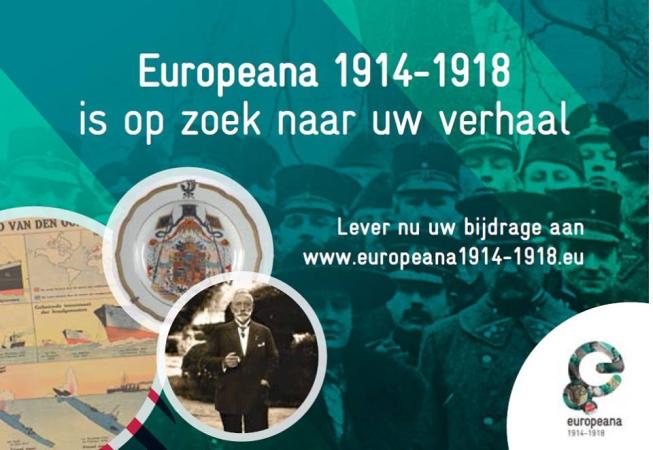On November 15, the Carnegie Foundation/Peace Palace Library took part in the Europeana Project and organized the first Europeana Collection Day in the Peace Palace. This special day focused on Europeana’s latest Project ‘Remembering the First World War’. This project enables anyone, private citizens or institutions, with memorabilia relating to the First World War to attend these collections days and share objects, letters or other documents about this interesting period in Europe’s History. On Saturday November 15, ten enthusiastic colleagues from the Carnegie Foundation volunteered to work on the Europeana Project and gathered early in the morning to prepare for this day.
In spite of the European nature of the project, the first guests we welcomed came from Mt. Pleasant, Michigan in the United States. Among them was Professor Hope Elizabeth May from Central Michigan University (CMU) and two of her students, Megan Blue and Taylor Ackerman, both of whom now study in the Netherlands. Professor May’s research on the 19th century Peace Movement in the U.S. literally led her to her own back yard at CMU, and specifically to the archives of former CMU President E.C. Warriner (1866-1945) who presided over CMU when it was known as ‘Central State Normal School’ (a ‘normal school’ was a teacher’s college). Prior to serving as President of CMU from 1918-1939, Warriner established the Michigan Branch of the ‘American School Peace League’ (ASPL) in 1910.
The ASPL was an extensive national network of U.S. educators committed to spreading awareness about the Hague Peace Conferences and the ‘Peace through Law’ movement of the 19th century. Within Warriner’s extensive archives, which are held by The Clarke Historical Library at CMU, May discovered numerous documents relating to the ASPL as well as notes and speeches written in 1914-1918 that discuss The Great War, its relationship to the Hague’s Peace through Law tradition, and public U.S. education at the time. May felt that these documents are an important part of the public memory of the war and hence should be included in the Europeana Project. “Warriner was deeply involved in the education aspect of this pre World War 1 Peace through Law movement and the papers submitted to Europeana reveal how the U.S. section of this movement struggled at a time when much of Europe abandoned the peace machinery established by the early Hague Peace conferences”, May said. “There are at least two important lessons connected to the CMU contribution to Europeana,” she continued. “One is that U.S. involvement in the Great War profoundly affected peace education in that country. The other is that there was extensive peace education in the U.S. at all.”
Besides Professor May and her students from CMU , we welcomed many other guests, mainly locals from The Hague, who mostly shared family memorabilia and collector items purchased at special auctions such as World War I posters, British medals and other military decorations. In spite of the heavy rain and the gray skies, many people managed to find their way to the Peace Palace to participate in this project. The first Europeana Collection Day was a success and we hope to repeat it with a second event in the Spring of 2015. Stay tuned for more information next year!!
About Europeana 1914-1918
The Europeana Project can be considered a European Virtual Library, consisting of millions of books, paintings, museum objects, archival records and films that have been digitized all throughout Europe. Together, these assembled collections make European Cultural Heritage available to everyone. Europeana 1914-1918 is a project funded under the Information and Communication Technologies Policy Support Programme. Europeana 1914-1918 will create a substantial digital collection of material from national library collections of ten libraries in eight European countries that found themselves on different sides of the historic conflict. In the following years, strong interest in the topic is expected from a wide variety of users – including the general public, local and family historians, education professionals, archives, museums and historical societies, people working in the media, the arts or in the tourism industry.
The items that will be included in Europeana Database will be selected with help from specialists and target user groups according to agreed quality criteria. They will span the full range of national library collections including books, newspapers, trench journals, maps, children’s literature, posters, pamphlets, propaganda leaflets, medals and coins. The digital collection will go far beyond any existing digital collection on the topic in terms of size, quality and diversity and make Europeana the first stop for quality content on the “Great War”. Europeana 1914-1918 will make a vast amount of sources available online for the first time – content that is often rare and highly fragile because of the deteriorating quality of the paper it was produced on and generally only accessible in reading rooms. The material will highlight the importance of WWI for a common European identity and be reflective of the different experiences of individuals and groups on all sides of the conflict including different ethnic, linguistic, political, social and religious communities and those opposed to the war.
